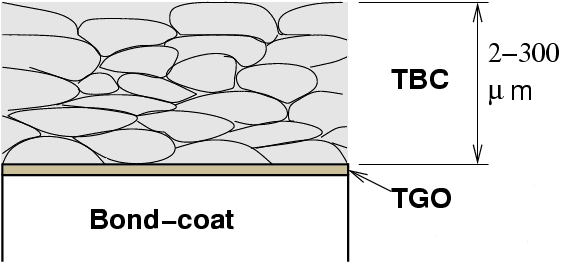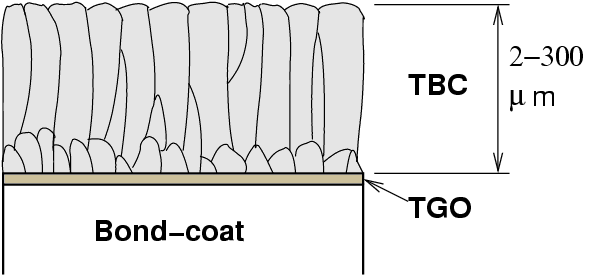For a ceramic coating to have any chance not to spall at the first thermal
cycle, it is critical that its thermal expansion be close to that of the
substrate.
For the coating to be of use, it must also exhibit a very low thermal
conductivity.
For this purpose, yttria(Y2O3)-stabilised
zirconia(ZrO2) (YSZ) is widely used. The addition of 5-15% yttria
stabilises the zirconia in its high-temperature crystalline form, therefore
avoiding phase-transition in the range of service temperatures.
Zirconia (ZrO2) based ceramics satisfy both requirements, with a
thermal expansion coefficient of 11-13x10-6 K-1 and a
thermal conductivity of about 2.3 W/(m.K) at 1000 oC for a fully dense
material, this can be further reduced by introducing porosity (Evans, 2001)
The very low thermal conductivity of YSZ is due to the presence of a high
concentration of point defects which scatter lattice vibrations (Padture, 2002)
Thermal barrier coatings can be obtained by different processes, such as
electron beam physical vapour deposition (EBPVD) or air plasma spray
(APS). These techniques are described in another section. Different techniques
result in significantly different microstructure. Although more costly than APS,
EBPVD is the preferred method for high-pressure turbine blades, as these result
in a microstructure which considerably enhances the strain tolerance:
 |
 |
Schematic microstructure of a thermal barrier coating (TBC)
obtained by air plasma spray (APS). The structure provides much less strain
resistance than the EBPVD counterpart, but is preferred for abradable seals
(DeMasi-Martin, 1994) |
Schematic microstructure of a thermal barrier coating (TBC)
obtained by electron beam physical vapour deposition (EBPVD). The columnar
microstructure considerably enhances the strain resistance and therefore thermal
cycling life. |
TBC coatings deposited by APS or LPPS (low pressure plasma spray) offer a
thermal conductivity significantly lower than that of a fully dense coating
(0.9-1 W/(m.K)), as the boundaries and pores tend to lie parallel to the surface
and therefore perpendicular to the temperature gradient.
By contrast, the thermal conductivity of EBPVD TBC is not as low (1.8-2
W/(m.K)), and lowering it further would imply further benefits (Schultz,
2003). EBPVD TBCs are nevertheless preferred becauce of the strain tolerance
imparted by the microstructure.
The lifetime of TBC coatings obtained by EBPVD has been reported to be
between 8 and 13 times longer than equivalent system where the TBC was deposited
by plasma spray (Schulz, 2003). As opposed to plasma spray methods, EBPVD does not
require a rough surface to adhere.
Current research includes attempts to tailor the microstructure of the TBC to
include benefits of both types of microstructures.
Bibliography
- Padture et al., Science, 296:2002, 280-284, 'Themal barrier coatings
for gas-turbine engine applications.
- Evans A. G. et al., Prog. Mater. Sci., 46:2001, 505-553, 'Mechanisms
controlling the durability of thermal barrier coatings'.
- Schulz U., Aero. Sci. Techn., 7:2003, 73-80, 'Some recent trends in
research and technology of advanced thermal barrier coatings'.
- DeMasi-Martin J. T. et al., Surf. Coat. Techn., 68/69:1994, 1-9,
'Protective coatings in the gas turbine engine'.

